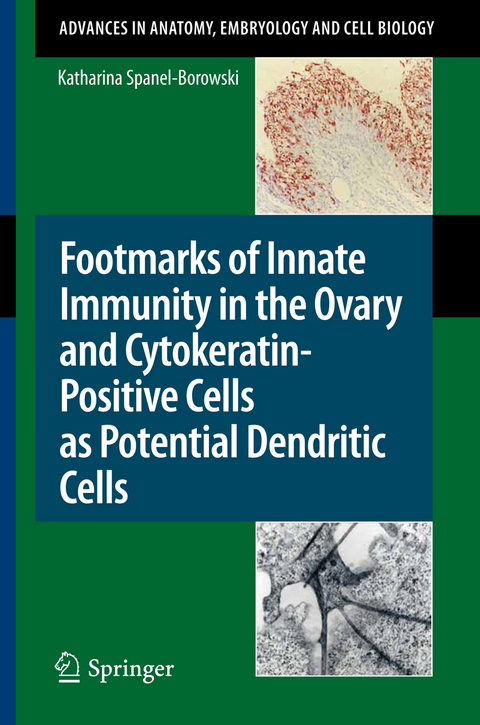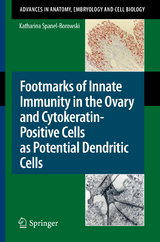Footmarks of Innate Immunity in the Ovary and Cytokeratin-Positive Cells as Potential Dendritic Cells
Springer Berlin (Verlag)
978-3-642-16076-9 (ISBN)
- Lieferbar
- Versandkostenfrei
- Auch auf Rechnung
- Artikel merken
1 Background.- 1.1 Innate Immunity, Toll-like Receptors (TLR), and Danger Signals 1.2 The Ovary, Tissue Remodelling, and Immune Privilege.- 1.3 Design.- 2 Material and Methods.- 2.1 Cyclic and Superovulated Ovaries from Rats, Hamsters, Rabbits as well as Canine, Bovine and Human Ovaries.- 2.1.1 Fibrinolytic Activity and Implants on the Chick Chorioallantois Membrane (CAM).- 2.1.2 Fixation, Staining and Counting Ovarian Structures.- 2.2 Cell Culture Subtypes from Follicles Derived from Patients Under in Vitro Fertilization Therapy.- 2.3 Cell Culture Subtypes from Bovine Corpus Luteum (CL) and Characterization.- 3 Footmarks of Innate Immunity.- 3.1 The Complement System as Danger Sensor in General and in the Ovary.- 3.2 Mild Danger with Mild Response.- 3.2.1 Implantation of the Ovary into the CAM.- 3.2.2 Follicular Atresia.- 3.3 Moderate Danger by Preovulatory Follicle Rupture and Acute Inflammation with Eosinophils.- 3.3.1 Recruitment of Eosinophils and Substance P-Like Expression.- 3.4 Severe Danger in Superovulated Ovaries with Intra-Ovarian Oocyte Release and Thrombus Formation.- 4 Cytokeratin-Positive (CK+) cell as Potential Dendritic Cells.- 4.1 Dendritic cells, the TLR System in General and in the Ovary.- 4.2 Localisation of CK+ Cells in the Intact Ovary.- 4.2.1 Follicles in Foetal and Adult Ovaries.- 4.2.2 Corpus Luteum.- 5 Characterization of Isolated CK+ Cells.- 5.1 CK+ Cells from Preovulatory Follicles with TLR4 Expression.- 5.2 CK+ Cells from CL in Comparison to CK-Negative (CK-) Cells.- 5.2.1 Effects of Interferon-gamma on CK+ Cells from the CL Compared to CK- Cells and to Surface Epithelial Cells.- 5.2.2 Reflections on Quality of the CK+ Type 1 and Similarity with the Type 5.- 6 Working Hypothesis and Challenges.- 7 Clinical Perspectives.- 8 Concluding Summary and Remarks.- References.- Subject index.
| Erscheint lt. Verlag | 9.12.2010 |
|---|---|
| Reihe/Serie | Advances in Anatomy, Embryology and Cell Biology |
| Zusatzinfo | XV, 110 p. 33 illus., 22 illus. in color. |
| Verlagsort | Berlin |
| Sprache | englisch |
| Maße | 155 x 235 mm |
| Gewicht | 288 g |
| Themenwelt | Medizin / Pharmazie ► Medizinische Fachgebiete |
| Studium ► 1. Studienabschnitt (Vorklinik) ► Histologie / Embryologie | |
| Studium ► 1. Studienabschnitt (Vorklinik) ► Physiologie | |
| Studium ► Querschnittsbereiche ► Infektiologie / Immunologie | |
| Schlagworte | Chick chorioallantoic membrane • Corpus luteum • Fetal ovary • Follicular atresia • Granulosa cells • Intra-ovarian oocyte release • Lox-1 receptor • Microvascular endothelial cells • Ovulation • Oxidative stress • Preovulatory follicle • Toll-like receptor 4 |
| ISBN-10 | 3-642-16076-X / 364216076X |
| ISBN-13 | 978-3-642-16076-9 / 9783642160769 |
| Zustand | Neuware |
| Haben Sie eine Frage zum Produkt? |
aus dem Bereich




